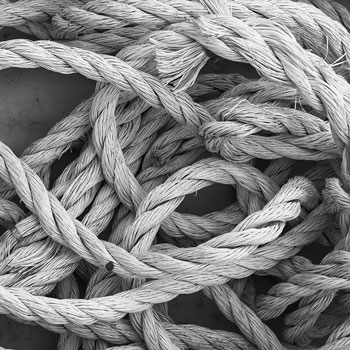So, What Do You Do With
Your Old Pot Warp?
by Eva Murray

When I was a kid, my grandfather lobstered out of South Thomaston. As a young man he’d fished in the Muscle Ridge, as his father had been light keeper on Two Bush. Growing old, in the 1980s, he mostly kept inshore, between the territories of the Spruce Head boys and the ‘Keag River guys. Colorful hulls were rare in his day, but my grandfather had a bright yellow boat, moored in the little cove a few hundred yards from his kitchen window. It wasn’t a bad racket, and although he didn’t make much money, he probably didn’t spend much, either.
When I moved to Matinicus Island in 1987 to teach school, I was introduced to an entirely different fishery. Unlike my grandfather’s haul-and-dump singles and pairs, my island neighbors fished trawls. The boats are bigger, the water is far deeper, and the amount of money that must be spent on replacing gear is orders of magnitude larger.
But even my grandfather had seemingly endless piles of half-rotted rope everywhere.
There are something like 6000 licensed lobster-catchers in Maine, and if even most of them fish the 800 trap limit, that’s between four and five million traps. I don’t have to explain how much rope is involved; most readers of this newspaper know better than I. For anybody else, consider that thousands of miles of plastic rope of several types and weights is in regular use, so the amount which needs to be changed out and replaced each year is not insignificant. Unlike the natural-fiber rope of an earlier day, the polypropylene, polyethylene, and other plastics used cannot biodegrade; they only break up into smaller and smaller bits, subject to ultraviolet light, wear and tear, and the sea.
We need an industry-wide,
user-friendly, full-time,
clean disposal mechanism.
Almost every fisherman I know has a mess of the stuff kicking around underfoot somewhere. Many transfer stations and recycling systems struggle when presented with large quantities of rope because it tangles up equipment like bulldozers (in landfills) and conveyor belts (in sorting facilities). In order to process the stuff easily it needs to be chopped, ground, or chipped somehow. People often suggest various re-purposing ideas, such as the manufacture of doormats, or the occasional large art project. That “upcycling” is fine as far as it goes, but in terms of helping with the quantity of rope in Maine, that is a drop in the bucket. We need an industry-wide, user-friendly, full-time, clean disposal mechanism.
In some of the more rural areas, as we all know (and I’m not divulging any secrets) the historic solution was fire, a leftover from the days of natural-fiber rope. However, a plastic rope fire is essentially an oil fire, resulting in a thick, black, toxic smoke, which is not exactly neighborly. Maine’s islands are tinderboxes these days, too, with dying spruce forests posing a serious fire hazard. Unnecessary open burning is not something we can take lightly any more.
Maine’s lobster industry needs a long-term arrangement whereby anybody can deliver mixed-type, used commercial fishing rope to any of a series of drop-off facilities, from which it can be trucked to trash-to-energy facilities or, possibly someday, plastics recyclers. I have begun discussing this idea with the Maine Lobsterman’s Association, Gulf of Maine Lobster Foundation, and others who worked to organize the float-rope buyback program back when the rules changed a few years ago, and who have done extensive research on gear configuration in Maine, as well as with folks working in the Maine solid waste industry. Maybe, over time, harvesters, marine suppliers, solid waste handlers, and local authorities can take the lead in designing a system to handle old pot warp--including that backlog which many of us have learned not to see as it piles up out back, under the shop, and in the way.
Matinicus Island, a remote community with an economy entirely dependent upon the lobster fishery, already trucks its recyclables to the mainland (despite what you might think,) and Matinicus is working toward a program where we truck our pot warp to a mainland processing facility as well.
I am interested in hearing from lobster harvesters statewide—anonymously is fine—about what they honestly do with out-of-service pot warp. I am also interested in whether your town or local solid waste facility has a disposal system in place for rope and what is done with it. Please feel free to e-mail me at eva@midcoast.com.
Eva Murray is the Recycling and Solid Waste Coordinator for Matinicus Island. Eva’s last lobster license was dated 1990, the year her son was born, and cost $53.00, which at the time she thought was an awful lot of money.
